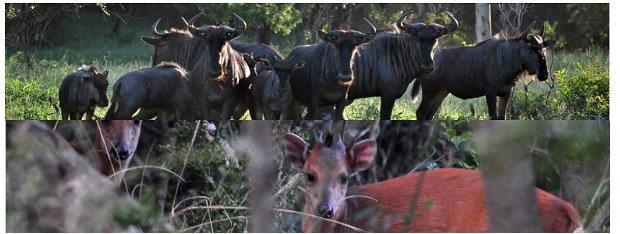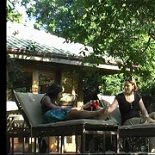BREEDING PATTERNS IN ZULULAND (PART 1)
This time of the year, it is not strange to hear funny noises in the bush, to see males fighting one another and males acting possessively..... male animals that is! It is breeding season! In this blog we are going to have a look at the common animals seen during the bushwalks, their breeding behaviour, reproduction and offspring.
Red Duiker (Tribe Cephalophini):
How do I know I am looking at a Red Duiker? They are cover-dependent antelopes of small to medium size, females slightly bigger than males. Stocky build with short legs, pointed hooves, rounded back, short tail, head proportionally large, small ears, black-slanted horns on both sexes, colour reddish brown.
Are they territorial? All Duikers rub their preorbital glands against tree branches, and other objects in their territories. Males and females mark in the same manner, but males do it far more frequently. Duikers do not maintain dung middens, but defecate at random throughout their territory.
How does reproduction work? Whether most Duikers breed perennially or seasonally remains unknown, but Red Duikers are thought to breed year-round in Southern Africa.
What is the parent/offspring behaviour like? Gestation period for Red duiker is unknown, but estimates of gestation vary widely and are often conflicting. Weight at birth is approximately 10% of the mother’s weight. Duikers have the typical hider-calf system.
Blue Wildebeest/Gnu (Tribe Alcelaphini):
How do I know I am looking at a Blue Wildebeest? They have a shoulder height of +/- 150cm, large, long head. Bridge of the nose covered in thick black hair. Horns curve sideways from the boss and then upwards and inwards. They have a long dark beard and throat fringe, dark vertical stripes on neck and shoulders and long black tail.
Are they territorial? Their territorial behaviour is the most complex and extra-ordinary of all bovids and has given the nickname “clown of the bush”. Bucking, cavorting, spinning like a top, leaping in the air, racing around in circles, kicking up the heels, shaking the head, pawing the ground and rolling, hardly seems functional activities and yet they are all part of wildebeest territoriality. The general pattern in Wildebeest society is a division into breeding herds, bachelor herds and territorial males. During the rut season bulls rarely leave their territories except to drink, because of the risk of returning to find another male has taken over. However, at the end of the rut they are less aggressive and territorial and may wander away for a few hours or even temporarily join a bachelor herd.
How does reproduction work? Few tropical mammals have such a restricted birth season as the wildebeest. Some 80%-90% of the calves are dropped during a 3 week birth peak. The timing of the calving and rutting is geared to the climate in such a way that both occur under favourable conditions. Given an 8 – 8.5 month gestation, the timing of the reproductive cycle represents a favourable compromise with the environment.
What is the parent/offspring behaviour like? The 3 week calving peak begins abruptly. Not many calves are born ahead of time. Wildebeest society is more structured at this time than any other season. There are groupings of pregnant cows and of cows that have calved, groups of yearlings newly separated from their mothers, and the bachelor herds, which are usually excluded by territorial bulls from the calving grounds. Each mother recognizes her own calf, initially by scent alone. Calves begin to nibble grass at 4-6 weeks and are weaned at 7–8 months. At about 4 weeks the horns first appear and grow into straight spikes, developing the characteristic wildebeest curves only at 12 months.
Keep an eye out next week for Part 2 of the Breeding season in Zululand were we will have a look at the Greater/Thick-tailed Bush baby and Nyala, both of which show extremely interesting breeding patterns.
References:
‘The Behaviour guide to African Mammals, Richard Despard Estes’
‘An introduction to the Larger Mammals of Southern Africa, A wildlife handbook’




Share This Post